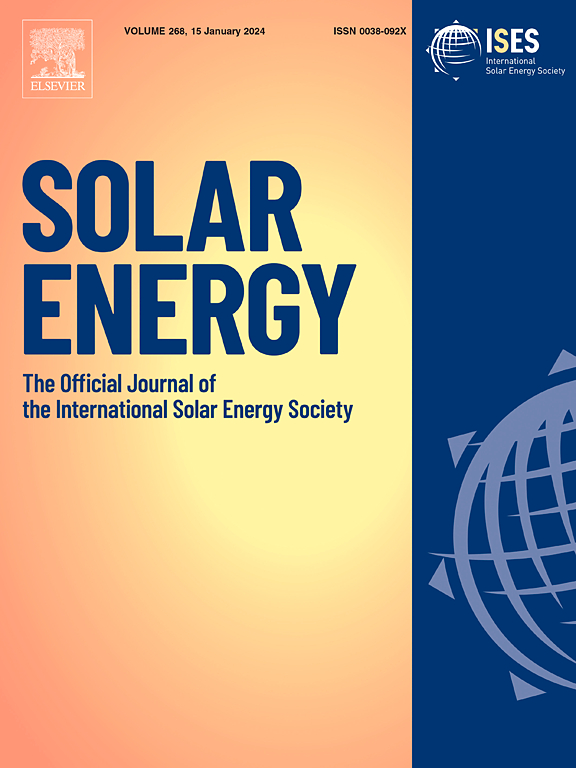阿塔卡马沙漠1兆瓦光伏电站的环境绩效:生命周期评估研究
IF 6
2区 工程技术
Q2 ENERGY & FUELS
引用次数: 0
摘要
光伏(PV)系统是减少环境影响和支持脱碳工作的可行解决方案,尽管其影响因安装位置而异。本研究考察了位于智利阿塔卡马沙漠的1兆瓦并网光伏电站的一次能源消耗和环境绩效,采用了根据ISO 14040和14044标准的从摇篮到坟墓的生命周期评估(LCA)。功能单元的定义是在30年的使用寿命内生产并向国家电网输送1千瓦时的中压电力。采用ReCiPe 2016 Midpoint (H)法,涵盖17个环境影响指标。阿塔卡马沙漠的独特条件包括高年度全球水平辐照值(>;2600千瓦时/平方米),每年1.5%的模块退化系数,逆变器等组件的加速磨损,适应盐碱化和腐蚀性土壤的土建工程,长途运输和有限的水资源。库存模型主要利用原始数据,包括现场测量和当地运营设施的操作经验。结果表明,由于光伏组件制造中使用的战略材料,除了矿产资源稀缺外,光伏能源在所有影响类别中都优于智利国家电网。气候变化影响和能源回收期分别为33.1 g co2当量/kWh和1.18年。在LCA研究中经常被低估的操作和维护活动被发现是相关的,由于加速部件更换,它们贡献了10 - 25%的环境影响。根据阿塔卡马沙漠不同地点的太阳辐照水平,相对影响可能相差高达30%。总之,越来越多的光伏太阳能发电为智利提供了一个有前途的、环保的、有竞争力的替代方案。未来的研究应该探索具有不同配置和组件的公用事业规模的光伏系统,以更好地了解其环境影响。本文章由计算机程序翻译,如有差异,请以英文原文为准。

Environmental performance of a 1 MW photovoltaic plant in the Atacama Desert: A life cycle assessment study
Photovoltaic (PV) systems are a viable solution for reducing environmental impact and supporting decarbonization efforts, though their impact varies significantly with installation location. This study examines the primary energy consumption and environmental performance of a 1 MW grid-connected PV plant located in the Atacama Desert, Chile, using a cradle-to-grave Life Cycle Assessment (LCA) according to ISO 14040 and 14,044 standards. The functional unit is defined as the production and delivery of 1 kWh of electricity at medium voltage to the national grid over a 30-year lifetime. The ReCiPe 2016 Midpoint (H) method was applied covering 17 environmental impact indicators. The Atacama Desert’s unique conditions include high annual global horizontal irradiance values (>2600 kWh/m2), a module degradation factor of 1.5 % per year, accelerated wear on components like inverters, civil works adapted to saline and corrosive soils, long transport distances, and limited water resources. The inventory models predominantly utilized primary data, including in-situ measurements and operational experiences from a locally operated facility. Results show that PV energy outperforms the Chilean national grid in all impact categories except Mineral Resource Scarcity, due to the strategic materials used in PV module manufacturing. Climate Change impact and Energy Payback Time were 33.1 g CO2-eq/kWh and 1.18 years, respectively. Operation and Maintenance activities, often underestimated in LCA studies, were found to be relevant, contributing 10–25 % of the environmental impacts due to accelerated components replacement. Relative impacts can vary by up to 30 % depending on solar irradiation levels across different locations in the Atacama Desert. In conclusion, the increasing adoption of PV solar power generation presents a promising, environmentally friendly, and competitive alternative for Chile. Future research should explore utility-scale PV systems with varied configurations and components to better understand their environmental impacts.
求助全文
通过发布文献求助,成功后即可免费获取论文全文。
去求助
来源期刊

Solar Energy
工程技术-能源与燃料
CiteScore
13.90
自引率
9.00%
发文量
0
审稿时长
47 days
期刊介绍:
Solar Energy welcomes manuscripts presenting information not previously published in journals on any aspect of solar energy research, development, application, measurement or policy. The term "solar energy" in this context includes the indirect uses such as wind energy and biomass
 求助内容:
求助内容: 应助结果提醒方式:
应助结果提醒方式:


